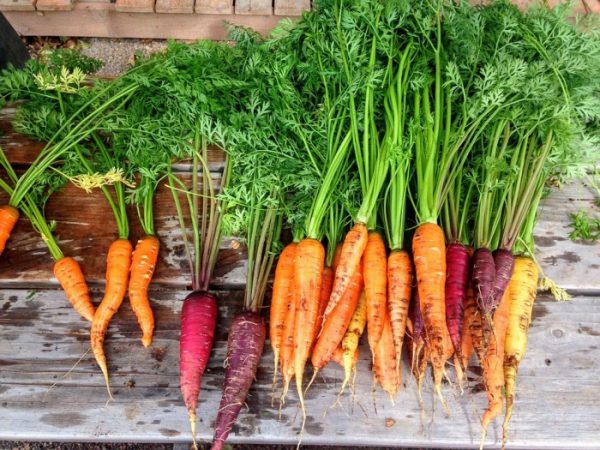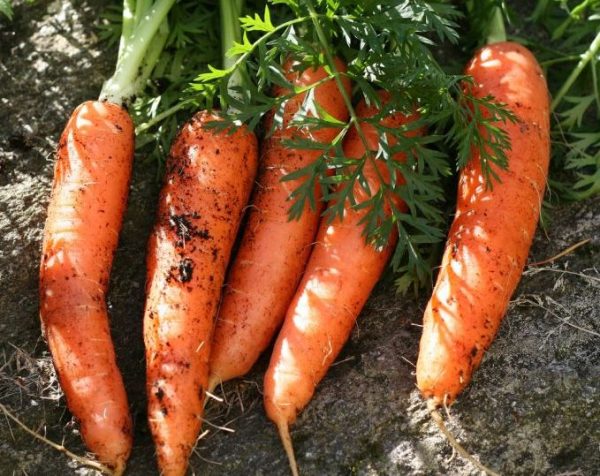Growing Carrots In Container:
The following information is about Growing Carrots in Container.
Introduction To Growing Carrots in Container
Carrot is a healthy vegetable that should be added to our regular diet. Carrot belongs to the family of Apiaceae and is called Daucus Carota botanically. Carrots are rich in beta-carotene, vitamin B6, niacin, and calcium. It is very good for the eyes and increases the hemoglobin levels in the body. Growing carrots can be a great idea and is very easy to grow. Carrot is a biennial plant and mainly grown for its taproot. Originally, carrot plants were grown for their leaves and seeds. Carrots are considered root vegetables. Carrots are available in many colors though we mostly grow the orange color. The other color carrots such as purple, red, black, white, and yellow can also be grown with similar kinds of regular carrot growing conditions. Sometimes carrot greens are also consumed. Carrots can be grown in containers, pots, terraces, the kitchen, and balconies. The growing practices of indoor carrots are a little different from growing outdoors. Let us discuss growing carrots in containers.
Carrot Botanical Name: Daucus carota subsp. sativus.
Quick Facts about Carrot plantation:
- Carrots have very tiny seeds and they should be planted very carefully.
- Carrots are very easy to grow.
- Carrot is a hardy root plant that grows well in cool weather.
- Seeds sprout at about 1 degree.
- They need loose aerated soil which is slightly alkaline and acidic.
- Carrots are pest-free when grown in containers.
- They take 50 to 100 days for harvesting.
Best time for Growing Carrots in Container
Winter is the best season to grow carrots, Carrots take more time to grow. Carrot is the best companion plant for another vegetable that grows in winter. Carrots are also sown from late May to late July.
Best Containers for Growing Carrots in Container
Carrots grew well in all types of containers with good height and width. The ideal container size is 6 to 15 inches deep depending on the variety of carrots. The container should be 12 inches deep, and with more width so that you grow as many as the carrot. You can choose large-ish clay pots, plastic bags, window boxes, plastic containers, planter bags, glass bottles, etc.
Varieties for Growing Carrots in Container
Short varieties of carrots are best for containers. There are many varieties of container-grown carrots they are imperator, chantenay, danvers, Exheart, Royal park, and nantes, etc. For container growing to select the variety that is smaller in size and has a less harvesting period.
- Imperators: This variety can reach a length of 8 to 12 inches, for this variety of carrots, choose 12 inches deep containers.
- Danvers: These carrots are good in taste, these carrots grow 6-7 inches long.
- Nantes: These cylindrical shape carrots grow to a minimum of 7 inches long. This is the best option to grow in a container.
- Chantenay: These carrots cone-shaped carrots and can grow up to 5 inches long.
Some other varieties are Romeo, Paris market, Babette or Hercules, etc there are even many varieties you should pick them checking size, length, and harvesting time.

Propagation for Growing Carrots in Container
Carrots are grown by using seeds or by carrot tops. Generally, carrots are grown using seeds and even they are propagated using tops.
To grow carrots from the tops, cut the tops of the carrots along with the green leaves on the top. And they planted about 250 cm deep, and the root will again start growing.
Carrots are very popular for their easy growing which doesn’t require high-quality soil and temperature-sensitive. Carrots are an attractive crop that has numerous flowers.
Soil Preparation for Growing Carrots in Container
Well-drained soil is the best one for carrots, soil should be very light and loose. Loose and aerated soil will help the root to grow freely. Many types of potting mixes are available in the market. If you have knowledge in preparing potting mix you can prepare it on your own. Soil should be stone-free and sandy. Carrots prefer acidic and slightly alkaline soil with pH levels 5.6 to 7.7.
Potting Mix with soil = soil + organic manure + perlite, all should be taken in equal compositions.
Potting Mix without soil = coco peat + organic manure + perlite + sand all is taken in equal compositions.
For these, you can add fertilizer to the potting mix.
Read this: Greenhouse Cucumber Production.
Sowing for Growing Carrots in Container
Once the potting mix is prepared, you should select a suitable and required container. Fill the container to about 3 inches from the top with soil. Now take the carrot seeds and sprinkle them on the planting bed evenly without leaving the place or can they planted in rows with spacing 15 cm from each other. And space can be thinned to about 8 cm apart once leaves start to appear. And after the sowing cover the seeds with a layer in the potting mix so that seeds should be at least ½ to ¼ inches deep from the surface. Make sure that all seeds should be covered. Once you complete the planting, water the bed regularly or alternatively. Make sure the soil is moist all the time.
Water and Temperature Requirement for Growing Carrots in Container
Water: To germinate carrot seeds, require a good water level constantly. You should water the plants regularly to maintain the moisture levels in the soil. You find the moisture level in the pot by popping the finger into your pots. You should careful in maintaining the water levels and don’t make the soil dry. Once the seeds start germinating you reduce watering frequencies, at this stage, more water can lead to growth crack in carrots.
Temperature: Carrots are winter vegetables so the seeds should be planted in late May, at that time when the temperature is 42 to 90 F. In general, the seeds take 10 to 20 days to germinate, in the case of low-temperature regions, they even take more time to germinate.
The ideal temperature to grow tasty carrot is about 60 to 72 F. So, containers need complete sun for 5 to 6hours, and the remaining time they should be moved into the shade.
Thinning in Growing Carrots in Container
Once the carrot root starts growing, thinning should be carried out. Thinning helps for better sunlight and aeration. You should maintain 2 to 3 inches of space between each plant. You should thin out the seedlings when they are 2 inches long.
Caring Tips for Growing Carrots in Container
- Make sure the container has adequate moisture. You should water the plant as per the seasonal requirements. And the container should have a drainage hole that helps to drain out the excess water.
- Don’t allow water logging in the container saucer which can restrict the root growth of carrots.
- You should feed the carrots with organic manure every 20 days to increases the nutrition levels in the carrots.
Fertilizers: For carrots, you should use fertilizers with low levels of nitrogen and high levels of phosphorous and potassium.
- You should Add some potting mix and organic manure during the mid-season.
- Liquid fertilizers are also preferred every 15 days as per the seed manual.
Pests and Diseases in Growing Carrots in Container
- Rust fly is a major problem that can affect carrots. To get secured from this you should buy a row cover and cover the plants to prevent the fly from laying legs.
- Weeds, pests, and some diseases can obstruct the growth of carrots.
- But in containers, you easily control the pests. Aphids and flea beetles can also destroy the growth of carrots but even these are managed very easily.
- Carrots are also affected by the fungus Sclerotiniasclerotiorum that forms a while mold to cover the carrot root. This fungus can be controlled by making sure the soil getting proper oxygen and water.
Harvesting in Growing Carrots in Container

- Harvesting time for carrots takes about 2 ½ to 3 months. The harvesting time of carrots depends upon the variety of carrots you choose. Even the climate and growing conditions also play a key role in harvesting time. So, carrots plant takes maximum 2 months of time and for baby carrots, you can harvest them early.
- Before harvesting, you should check the size of carrots, remove the dirt from the top of the root and check the size of the root.
- Now pick the selected ones and pull them gently and even sometimes they need a wiggle.
- Wash off the soil and make them eatable.
In case if you are interested in this: How To Grow Organic Lettuce.
- Economical Aquaculture: A Guide to Low-Budget Fish Farming
- 15 Common Planting Errors That Can Doom Your Fruit Trees
- How to Make Houseplants Bushy: Effective Tips and Ideas
- Innovative Strategies for Boosting Coconut Pollination and Yield
- Pollination Strategies for Maximum Pumpkin Yield
- The Complete Guide to Chicken Fattening: Strategies for Maximum Growth
- Natural Solutions for Tulip Problems: 100% Effective Remedies for Leaf and Bulb-Related Issues
- Revolutionizing Citrus Preservation: Towards a Healthier, Greener Future
- Natural Solutions for Peony Leaf and Flower Problems: 100% Effective Remedies
- Maximizing Profits with Avocado Contract Farming in India: A Comprehensive Guide
- Natural Solutions for Hydrangea Problems: 100% Effective Remedies for Leaf and Flowers
- The Ultimate Guide to Choosing the Perfect Foliage Friend: Bringing Life Indoors
- From Sunlight to Sustainability: 15 Ways to Use Solar Technology in Agriculture
- The Ultimate Guide to Dong Tao Chicken: Exploring from History to Raising
- The Eco-Friendly Makeover: How to Convert Your Unused Swimming Pool into a Fish Pond
- Mastering the Art of Delaware Chicken Farming: Essentials for Healthy Backyard Flocks
- 20 Best Homemade Fertilizers for Money Plant: DIY Recipes and Application Methods
- How to Craft a Comprehensive Free-Range Chicken Farming Business Plan
- Brighten Your Flock: Raising Easter Egger Chickens for Beauty and Bounty
- How to Optimize Your Poultry Egg Farm Business Plan with These Strategies
- Subsidy for Spirulina Cultivation: How Indian Government Schemes Encouraging Spirulina Farmers
- Ultimate Guide to Raising Dominique Chickens: Breeding, Feeding, Egg-Production, and Care
- Mastering the Art of Raising Jersey Giant Chickens: Care, Feeding, and More
- Ultimate Guide to Raising Legbar Chickens: Breeding, Farming Practices, Diet, Egg-Production
- How to Raise Welsummer Chickens: A Comprehensive Guide for Beginners
- How to Protect Indoor Plants in Winter: A Comprehensive Guide
- Ultimate Guide to Grow Bag Gardening: Tips, Tricks, and Planting Ideas for Urban Gardeners